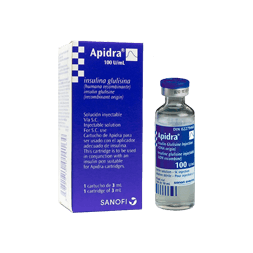Buy Apidra Insulin Vial from Canada
Apidra Vial
Apidra insulin vial contains the active ingredient Insulin Glulisine which helps in controlling high blood sugar levels in individuals with type 1 and type 2 diabetes mellitus. The FDA-approved vial contains 100 units of insulin glulisine, with 10 ml containing 10 units. The medication is typically prescribed alongside a medium or long-acting insulin or other diabetes medications to help reduce the chances of serious complications of diabetes. Apidra is intended for subcutaneous or intravenous use with external insulin infusion pumps. A healthcare professional should teach proper administration. However, it is not recommended for individuals with hypoglycemia or hypersensitivity to the medication.
Product Overview
Apidra Insulin Vial is a prescription medication containing a fast-acting solution of insulin glargine. This main ingredient is used for controlling high blood sugar levels in individuals with diabetes mellitus. Apidra works by replacing naturally produced insulin, facilitating the entry of glucose into cells for energy and inhibiting liver glucose production.
The vial contains Apidra insulin, and the recommended dosage is administered subcutaneously, usually within 15 minutes before a meal or within 20 minutes of starting a meal. It is suitable for adults, adolescents, and children aged six and above, including those with type 1 diabetes over four years old and adults with type 2 diabetes. Apidra is typically used in conjunction with medium or long-acting insulin or other diabetes medications.
Common side effects include hypoglycemia, which requires careful monitoring. Apidra is contraindicated in individuals with hypersensitivity to its ingredients and during hypoglycemia episodes. Precautions are advised for use in pregnancy, breastfeeding, liver or kidney disease, and elderly individuals. In case of a missed dose, follow your healthcare professional’s guidance. For overdose, seek immediate medical attention. Store unopened vials in the refrigerator and opened vials at room temperature for a specified period. Consult your healthcare professional for dosage adjustments and any concerns.

Uses of Apidra Vial
Apidra Vials are used for:
- Type 1 diabetes in adults and children above 4 years of age.
- Type 2 diabetes in adults only.
[Note: It is not known if Apidra is safe for use in children less than 4 years old with diabetes mellitus or children with type 2 diabetes.]
How to Use an Apidra Vial?
Strength of Apidra Vial
Apidra insulin vial contains:
- 100 units of insulin, with 10 ml containing 10 units.
Here is a step-by-step guide to administering Apidra Vial:
- Apidra is given by putting a shot ,subcutaneously usually in the fatty tissue. The best injection sites are the abdomen, thigh, or upper arm. However, if you inject Apidra in your stomach, it is more likely to work more efficiently. It is important to rotate the injection site each time you inject.
- Before giving the Apidra insulin, make sure your hands are clean and get all the tools you need, like the Apidra 10 ml vial, syringe, and alcohol swab.
- Look at the Apidra Insulin vial to see if it is broken, cloudy, or has particles. It needs to be clear and colorless. If there is any problem, you shouldn’t use it and should talk to your doctor or pharmacist and get a new Apidra 10 ml vial.
- Fill the syringe with the right air and shoot it into the vial. This keeps a vacuum from forming while the insulin is being taken out.
- Turn the bottle and syringe upside down and ensure the needle is in the insulin. Pull the button back to get the right amount. Look for air bubbles and get rid of them if you find any.
- Use an alcohol swab if you have one, or use soap and water to clean the chosen injection site and let it dry.
- Pinch the skin around the chosen injection site, put the needle in at a 90-degree angle, and slowly and steadily deliver the insulin.
- Gently pull out the needle, put a little pressure on the injection site, put the needle in a sharps container, and safely dispose of it.
- Follow the manufacturer’s advice for how to store the Apidra Insulin Vial. It should usually be kept in the fridge but not frozen. After it has been used, it can be stored at room temperature for some time.
- Check your blood sugar levels regularly as your doctor tells you to, considering what you eat, how active you are, and any changes to your treatment plan.
[Note: Your doctor will decide the right amount for you based on your condition, following guidelines and studies on the drug. They’ll adjust it as needed over time.]
How Does Apidra Vial Work?
The solution in Apidra Vial replaces the natural insulin produced by your body. This helps the glucose get into your cells so your body can utilize it for energy. It also stops your liver from producing glucose. It starts working within 15-20 minutes of taking it, and its effect can last for 3-5 hours.
Side Effects
Listed below are some of the most common side effects of insulin glulisine:
- Hypoglycemia
- Weight gain
- Allergic reactions
- Injection site reaction
Usually the side effects go away within a few days, but if they still persist, please consult your healthcare provider. They will also guide you on how to prevent and overcome the side effects.
[Note: If you experience severe side effects from taking Apidra, immediately contact your doctor. In cases where the side effects of the insulin appear life-threatening, or you believe you are facing a medical emergency, call 911 or your local emergency services immediately.]
Precautions
- Consult your doctor before starting any new medication. They will help you decide which medication will work best for you. Consult them if you have any queries or concerns.
- Apidra insulin should be used cautiously in women who are pregnant or breastfeeding.
- You should not drive or operate machinery if you have symptoms of low or high blood sugar levels; it may affect your ability to concentrate and react.
- Avoid consuming alcohol while on Apidra, as it can further lower your blood sugar levels.
- Apidra should be used with caution in patients who have medical conditions related to the kidney, heart, and liver.
- Do not use Apidra if you are allergic to Apidra or inactive ingredients.
- Apidra is not for use during episodes of hypoglycemia.
Missed Dose
- Since Apidra is taken 15 minutes before a meal or 20 minutes after starting a meal, it might not be easy to be on a timed dosing schedule.
- However, ensure that you take it within the prescribed time period.
- Do not use two doses at the same time.
- Keep Apidra insulin vial with you always, and get a refill before the medication is finished.
[Note: If you have missed a medication dose and are unsure when to take the next one, immediately consult your doctor or pharmacist.]
Overdose
Seek immediate emergency attention if you think you have taken the medication more than prescribed. Insulin glulisine overdose can cause hypoglycemia. Symptoms include:
- Dizziness
- Confusion
- Numbness
- Weakness
- Loss of consciousness.
[Note: If you consumed more than the recommended dose, get medical help right away or call the Poison Help line at 1-800-222-1222.]
Storage
- Follow the manufacturer’s advice for how to store the Apidra Insulin Vial.
- It should usually be kept in the fridge but not frozen.
- After it has been used, it can be stored at room temperature for some time.
[Note: Discuss with your healthcare professional the proper disposal of unused medicine and any questions you may have regarding its storage.]
Insulin Glulisine Interactions
Many medications may interact with insulin glulisine and affect the working of Apidra vial, including:
- Medicines: Medicines that can increase or decrease the effect of insulin glulisine, such as corticosteroids, beta-blockers, ACE inhibitors, fluoroquinolones, ethanol, macimorelin, and many others
- Foods and Beverages: Carbohydrates, alcohol, and artificial sweeteners can increase or decrease your blood sugar levels.
- Disease: Renal/liver disease, hypokalemia, and hypoglycemia can affect your blood sugar levels and insulin needs.
[Note: This isn’t a complete list, and there could be other drugs that interact with Apidra. This includes prescription and vitamins, over-the-counter medicines, and herbal products. Keep in mind that not all possible interactions are mentioned here.]
Frequently Asked Questions
How can I adjust my Apidra Insulin Vial dosage?
Any adjustments to your Apidra Insulin Vial dosage should be discussed with your healthcare provider. Their recommendations will consider your blood sugar levels, diet, and overall health. Self-adjusting blood sugar levels without professional guidance can have serious health risks. Whenever you change your insulin regimen, seek medical advice.
Is it safe to use an expired Apidra Insulin Vial?
It is not recommended to use expired Apidra Insulin Vials. When a medication expires, its potency and effectiveness are guaranteed to be at their peak. It may cause health complications if expired insulin is used to control blood sugar.
Are Apidra Insulin Vials compatible with other insulins?
Apidra Insulin Vial should not be mixed with any other type of insulin without consulting with your healthcare provider. Although some insulins can be mixed, others should not be combined due to potential interactions. Your doctor will help you with the correct technique and precautions when mixing insulin.
Can Apidra Insulin Vial be used in children and adolescents?
It is safe to use Apidra Insulin Vial in children and adolescents. The dosage and administration need to be decided by a healthcare practitioner based on your age, weight, and specific needs. Consult your healthcare provider once you receive the Apidra vial.
Our Guarantee
At ArcticMeds.com, we assure you the most affordable price to buy Apidra Vials online from Canada. Rest easy knowing that your order will be dispatched from a reputable Licensed Canada Pharmacy Online, adhering to the highest standards of quality and authenticity. Our discounted vials are shipped directly from Canada to your doorstep, ensuring a swift and secure delivery experience. To conveniently access Apidra Vial at a substantial cost, call us at 1-888-779-2193 toll-free.


